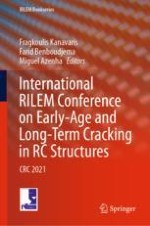2021 | OriginalPaper | Buchkapitel
Validation of Thermo-hygro-Mechanical FEM Analysis of Thick Restrained RC Members by Comparison with Experiments
verfasst von : Cláudio Ferreira, Dirk Schlicke, Carlos Sousa, José Gomes, Rui Faria, Miguel Azenha
Erschienen in: International RILEM Conference on Early-Age and Long-Term Cracking in RC Structures
Aktivieren Sie unsere intelligente Suche, um passende Fachinhalte oder Patente zu finden.
Wählen Sie Textabschnitte aus um mit Künstlicher Intelligenz passenden Patente zu finden. powered by
Markieren Sie Textabschnitte, um KI-gestützt weitere passende Inhalte zu finden. powered by
